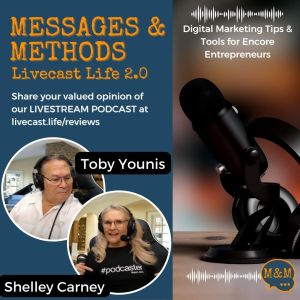As with every industry, there are a few top YouTubers we point to who are raking in millions while the rest of us struggle to reach 20 or more views per video.
So how do content creators monetize their work?
In this episode, Shelley and Toby explore the statistics and add their personal experience to explain how even a small audience can provide a path to financial success for the content entrepreneur.
YouTube Creators Can Make a Lot of Money – But Most Don’t
As with every industry, there are a few top YouTubers we point to who are raking in millions of dollars, while the rest of us are struggling to get 20 or more views on every video that we put out.
So we’re asking ourselves, how do content creators monetize their work?
We are going to explore some statistics and tell you about our personal experiences to explain how even a small audience can provide a path to financial success for the content entrepreneur.
News Update
I opened up my email and saw that Converge had sent me their Content Amplification Report. It’s a statistical report talking about B2B marketers and their experience over the past few years with content marketing and where they’re headed with it in the future.
What stood out for me is that the thing that stops content creators from amplifying their content is a lack of time due to other tasks.

As content creators, we focus mostly on creating content, but eventually, we need to think about monetization and that’s going to take us into building our own digital products.
That takes time away from our content creation.
That’s why I created the Content Consistency Framework and Schedule.
It outlines the fun, creativity-strengthening habits that help you produce consistent content so you gain momentum and expand your brand and reach.
The framework contains information that I have put together using my years of experience, but I’ve distilled it into two infographics: a framework and a schedule.
It shows you exactly what to do and what habits you need to incorporate into your life to be a consistent content creator and still have time for those other important business tasks, and oh yeah, enjoying life too.
Go to framework.agkmedia.studio, to find answers to these questions:
- How can I stand out online and connect with my target audience?
- How do I quickly create engaging content every week?
How Long Does It Take Content Creators to Monetize Their Work?

What’s the return on this investment of my time and effort?
Let’s start off with the content entrepreneur timeline that was presented in the Creator Economy Benchmark Research for 2022.
It takes over six months for a full-time creator to make their first dollar and then another 10 plus months to be self-supporting.
Creator Economy Benchmark Research for 2022
For a lot of us, it takes at least 17 months before we’re earning a consistent income from clients or customers buying our products and services.
We had that same experience in 2017 when we started live streaming. Within six months, we had made our first few dollars, and we knew we were on the right track at 10 months.
I think the big difference is if we were to start from scratch again today, based on what we’ve learned, we might take a different approach.
YouTube Content Creators Can Make Money

Each of the platforms has its own set of criteria that you have to follow to get into a position to make money.
For example, on YouTube, you can’t start making money from YouTube advertising and creator perks until you have at least a thousand subscribers.
I believe YouTube is the easiest platform from which to make money. YouTube pays you for content creation and distribution on its platform.
That doesn’t mean that just because you create content, you’re going to make money.
If YouTube doesn’t see you creating the content that’s going to interest their viewers, then they don’t promote your channel or content.
I could make an argument that all PewDiePie does is play Minecraft and tell jokes.
If you tune into PewDiePie, you see he has tens of thousands of online viewers when he is playing Minecraft because he’s very good at it. The people watching him learn from him.
That is true of a lot of the game players that make lots of money playing games on YouTube.
YouTube pays you for views and watch time, even if you sell nothing.
The platforms help you if you know how to take advantage of what the platforms want from you.
The Average Annual Revenue for Full-Time Creators
The average annual revenue for full-time creators is greater than $100,000. But that average accounts for a relatively small number of high flyers who earn handsomely. The median, or midpoint revenue, is half that: $50,000. Keep in mind that this number describes all full-time creators who earn money, whether they’ve worked for six months or six years.
2022 Creator Economy Benchmark Research
The description, full-time creator, indicates that these people work within a business model, creating content and distributing that content for an average of eight hours a day, five days a week. Many creators put in more hours than that, especially in the beginning.
Becoming a content entrepreneur means committing to working 40 hours a week on content creation and distribution and all the business tasks that go along with that.
You Can Make Money With a Small Audience

Even if you’re not getting advertising revenue from YouTube, if you have a loyal audience who likes and trusts you, and they have money to spend, they’ll buy from you.
Having a hundred true fans who want to buy whatever digital products you create means you have a viable business that supports you financially.
Finding Time to Create Physical and Digital Products
Toby has two adult children, Jason and Sean, who are artists. They’ve had a lot of success, but if they had their own YouTube channels where they consistently talk about how they do what they do, that would provide them a way to market their products.
They both have Etsy stores. They could show their tricks, techniques, and tools, then refer you to their Etsy stores.
Jason sells tool packages because he uses specific tools when doing tin work.
They spend so much time making a living and creating their work; they don’t feel they have the time to create and distribute associated content.
How Much Time Do You Spend Marketing?

Most artists don’t know how much time they spend marketing because it’s an integral part of their day-to-day effort of creating and distributing their products.
People call and ask for more products or deliveries. They integrate promotion within the effort of creating and selling their art, so they don’t think of it as marketing.
Every year, during the last weekend in July, they hold Spanish Market in Santa Fe. Jason and Sean rent a booth and sell their work there. Hundreds of people walk by their booth. Even if they can’t afford the pieces they see, they take a business card. It has their Etsy store information.
Jason and Sean prepare all year round for Spanish Market and they go to several of these kinds of shows throughout the year. It’s hard to find time for creating their art and marketing.
Why don’t you have a marketing tool that’s always working for you?
Spend two to three hours a week building content on YouTube that is always selling for you. You don’t have to rely on Spanish Market once a year.
How Much Time Do Content Creators Spend on Content Production?
Being a creator is only fractionally about producing content. On average, full-time content creators spend about half their time creating content. The other half is spent on business issues like content distribution, promotion, marketing, sales, and administration/operations.
2022 Creator Economy Benchmark Research
Most YouTubers who make living incomes are doing it based on the content that they create.
I know three or four creators who make a living on YouTube talking about drones.
They talk about a drone and give their expert opinion, then in their description box, there’s a link to purchase that drone. They get a commission from that which may be their entire source of income because they have hundreds of thousands of subscribers.
When you look at their content, it’s a fully produced video that requires hours of shooting from a script. Somebody takes that content and edits it into a professional 20-minute video that you eventually see where he does a review on the newest DJI product.
We count all that production work as a part of the full-time hours content creators work.
Shelley wrote a LinkedIn article over the weekend that required several hours’ worth of research, conversation, and sitting at the computer writing, formatting, and uploading to LinkedIn.
It’s another part of the effort that goes into the work of a content entrepreneur.
Audience First Strategy
There is a strategic integration of your content where one piece highlights the other.

The LinkedIn article highlights the show from last week, the show from this week, and other things that we’re doing and it brings everything together.
That integrated content wraps around readers as the customer experience.
As you look at the current ways to make money online, and what’s working best, most of it centers on creating content.
Three ways you can create content to bring people to you:
- Create a YouTube channel
- Start a blog
- Build an online store
First, you grow the audience, then you sell your products to that audience.
More than half of full-time content creators are self-supporting and nearly one in five say they earn a substantial income.
2022 Creator Economy Benchmark Research
Content creation is a good industry to get into. You just have to remember to treat it like a full-time business and not expect everything to be easy. You’ve got to work at it every day.
We do at least the minimums every week.
Read our blog post Content Creator Foundational Habits to learn more about what we consider the minimum requirements for our content creation business.
SHELLEY: When I went to visit my mom for 5 weeks this summer, I could still do my minimums and get my work done. But I wasn’t working full-time hours. I didn’t take on anything extra.
Now that I’m home, I’m doing more outreach, appearing on other people’s podcasts, and all the additional things that go along with being a content entrepreneur.
What is Most Challenging About Being a Content Entrepreneur?

We are content creators and we’ve been doing this for a while. It’s one thing to hear about people making money, but it’s another to hear from people who are actually doing the work and growing a business.
TOBY: It’s hard to be motivated when you’re 73 and you’ve already put in 50 years working hard at what you’re good at.
Although I believe the best years of my life are ahead of me, they’re not the best years of my working life.

I’ve already accomplished what I needed in life to get my kids grown and off on their own.
I was successful at being an independent contractor to the federal government, and I was good at it. I made a great living at it, enough to raise six kids and keep everybody happy.
Yet, I don’t want to be that retiree that spends his life sitting on the front porch, watching the rest of the world go by.
My challenge right now is: how do I combine being a content creator with something that motivates me?
What makes you get out of bed in the morning?
Being a content creator and distributor is not enough to get you up in the morning. I can tell you that from experience.
You need to have another reason and that means whatever you’re doing has to positively affect you, and ideally, positively affect someone else.
What is the reason that you enjoy content creation so much that you’ve been doing it for so many years?

TOBY: I was a newspaper reporter and photographer for my high school newspaper, El San Miguel. That means I’ve been a content creator most of my life.
I am technically astute and understanding technology challenges me. When new things come around, I’m always excited. I can take advantage of them, figure them out and use them to reach people.
I’ve been on YouTube since 2006 when it first started, so I know that producing and distributing content has never been easier than it is today.
Amazing technology sits in my house: a one-gigabyte modem, a camera, lights, studio monitors, touch screens and microscope cameras that I can share on screen. All the technology and what it can do is amazing to me.
Technology is my motivation for waking up to find out what comes next.
But being excited about what comes next may not be enough.
When I finish a show, I’m thinking about where I’m going to go fishing this weekend. Or I’m thinking about how to build a trailer for a boat for less than a thousand dollars and make it useful.
I have all these other things that are running through my head that have nothing to do with producing and distributing content.
So, staying focused on the production through distribution, that’s the challenge.
Opportunity and Potential
SHELLEY: What motivates me is opportunity and potential.
I want to express my potential by learning and applying the things that are available to us.
Today on Women Conquer Business, I listened as Jen went over all of her social media scheduling apps, how they work, and how she uses them.
I absorbed all that information and understand it much better than I did a year ago because I’ve worked with it.

I want to use technology and information in a way that provides a platform for making the world a better place.
I can take this information and teach it to other people and they can share their activism, coaching, or spirituality that they want to express.
I’ve explored my potential, now I can help them explore their potential.
I feel like I am a conduit: somebody who can help other people get their message out to the world.
That’s my Dharma, my calling in life. My life path number is three, which is about communication.
Communication is my potential. What can I do with it? How many opportunities are out there? How can I expand my reach and brand, so that opportunities will pop up?
I was watching a LinkedIn live show this week, and the hosts were talking about the Content Entrepreneur Benchmark Research. They were people from The Tilt. I commented I love this research. I talk about it on my podcast and in my LinkedIn newsletter.
Pam Pulizzi from The Tilt came on and said, Give me links.
So I gave her links.
That was an opportunity that popped up because I showed up live, interested in learning more about content creation. I expressed that I enjoyed their work. Now they want to see my work. There’s potential in that exchange.
Exploring possibilities and having opportunities pop up is so exciting.
My heart started beating faster and my mind lit up with the thought, what more could happen?
Imagine this…

I’m inserting coins into a vending machine and think I’m going to get a club soda.
I keep putting money in this vending machine, thinking a club soda is going to come out soon.
But what comes out is something that’s even better. It’s the most wonderful drink I ever had, and I didn’t even know it existed.
The important thing is I kept putting those coins in until I got something back.
I was expecting something good.

What I got was even better. It was life-changing.
The same is true for content creation.
We must keep putting that effort in again and again until we receive something wonderful.
An amazing opportunity will come out of it and we can explore our potential further.
That’s why I commit to content creation and distribution.
It Takes Persistence
Part of the frustration of becoming a content creator and distributor is that schools do not train us to be persistent.
Persistence is something that you earn. Over the years of life experience, you realize to accomplish something takes persistence and commitment.
How can I stand out in a crowded marketplace online?
How can I feel motivated to create content consistently?
If you are a content creator, coach, speaker, or somebody who just wants to expand your brand online, this is a wonderful opportunity to explore your potential.
Check out our Content Consistency Framework and Schedule at framework.agkmedia.studio.
Inspiration to Commit
“Whenever you have trouble getting up in the morning, remind yourself that nature has made you for the purpose of working with others.”
MARCUS AURELIUS, MEDITATIONS, 8.12
Why do we get out of our comfortable beds and get to work?
Because humans are designed to work with others. It is our purpose.
People are depending on you, and your purpose is to help all of us to make the world a better place. We’re waiting and excited for you to show up.
Explore your potential and become a successful content entrepreneur by committing to work full-time hours and keep putting out the best content you can.
If you need support, have questions, or want to share your vision for making the world a better place through content creation, schedule a video call with us at http://consulting.agkmedia.studio
Send in a voice message: https://anchor.fm/messagesandmethods/message
